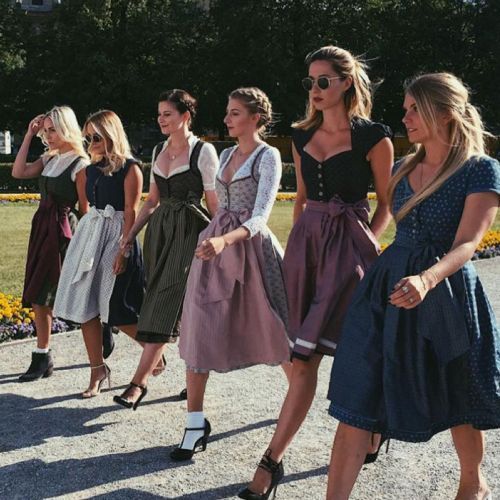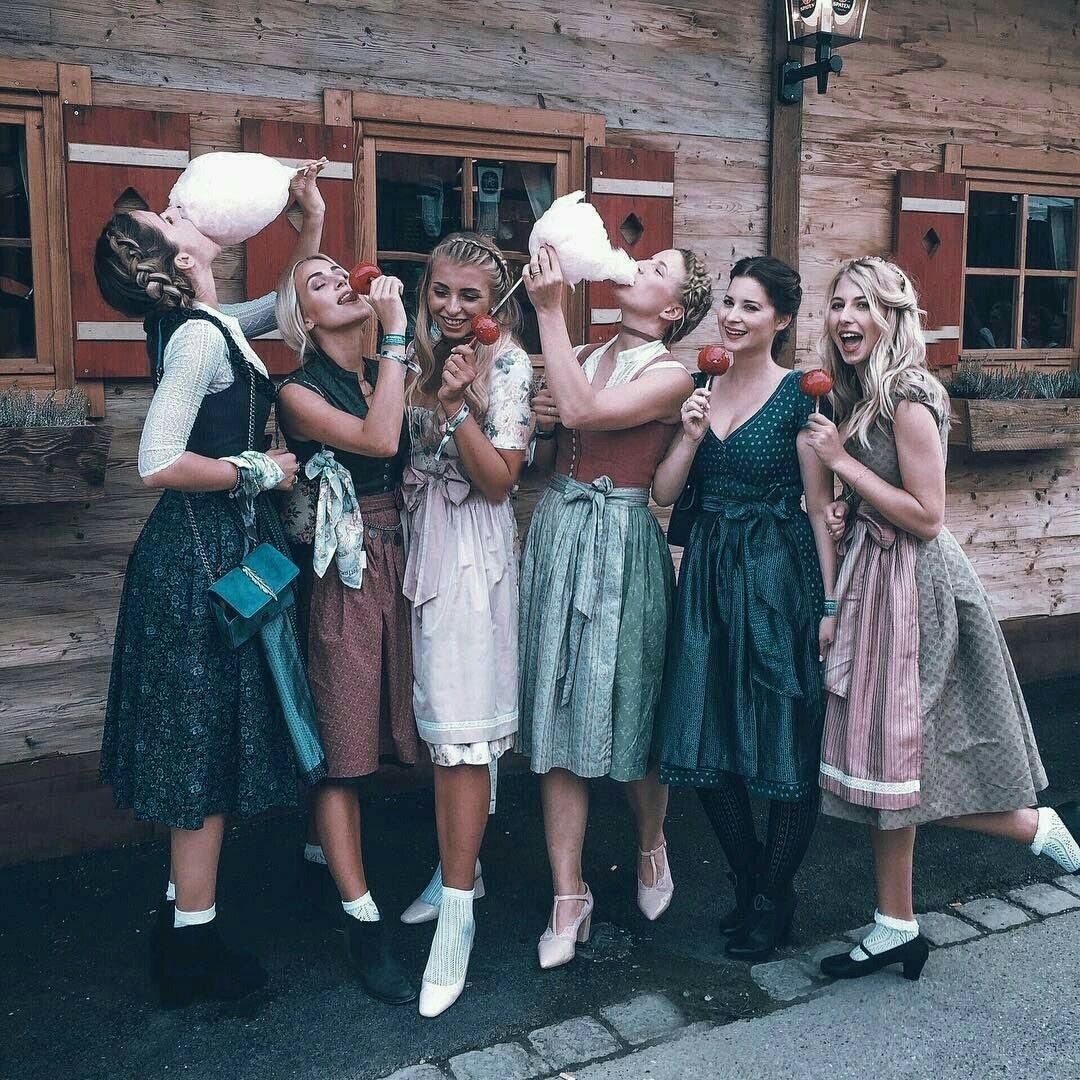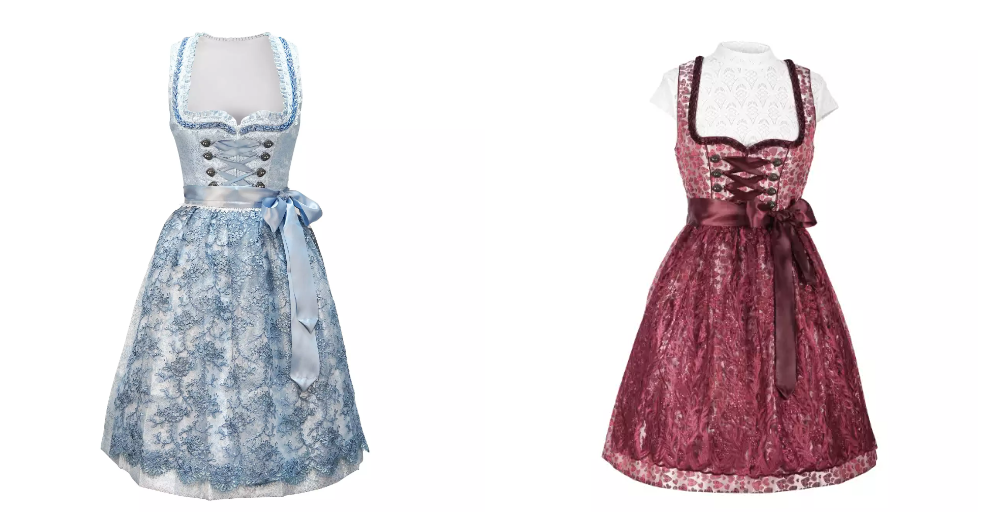
Dirndl dresses have a rich history dating back to the 19th century in the Alpine regions of Austria, Germany, and Switzerland. Originally worn by peasant women as work attire, the dirndl dress has evolved into a cultural icon and is now a beloved item in women’s fashion.
In this article, we will explore what a dirndl dress is, why it is so special, and how to wear and care for one.
The Anatomy of a Dirndl Dress
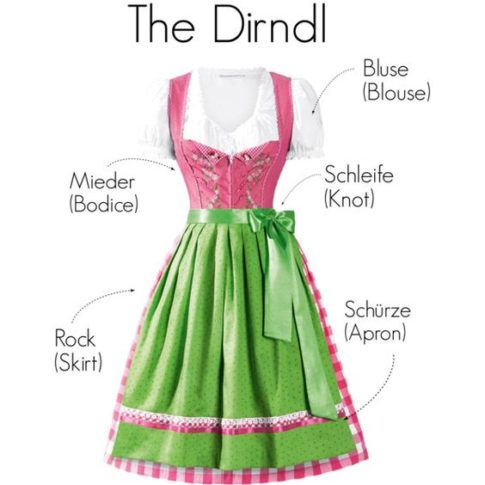
source: https://historicalsewing.com/
A dirndl dress typically consists of 4 parts: the bodice, skirt, apron, and blouse. Each component plays an essential role in creating the classic look and feel of a dirndl dress.
Bodice
The bodice is the tightly-fitted top of the dress, designed to accentuate the wearer’s waistline and bust. It can be made from a variety of fabrics and features different neckline styles, including a square, sweetheart, or V-neckline. The bodice typically fastens in the front with hooks or buttons.
Skirt
The skirt of a dirndl dress is often full and flouncy, with varying lengths ranging from above the knee to ankle-length. The fabric used for the skirt is typically lightweight and flowy, such as cotton, silk, or satin. Some dirndl dresses feature an underskirt or petticoat to add volume and movement to the skirt.
Apron
The apron is an essential part of the dirndl dress, worn over the skirt. It can be made from the same or contrasting fabric and provides a pop of color and dimension to the dress. The apron is typically fastened at the waist with a ribbon bow or a metal clasp.
Blouse
The blouse worn with a dirndl dress is usually made from cotton or linen and features short or long sleeves. Some blouses feature intricate embroidery or lace detailing, adding a touch of elegance to the outfit. The neckline of the blouse can also vary, with options including a Peter Pan collar or a scoop neck.
There are also variations of dirndl dresses offering different styles in length, neckline, and sleeve styles. Midi or maxi length skirts are popular for more conservative events or formal occasions, while shorter lengths work perfectly for casual wear.
Understanding the anatomy of a dirndl dress is critical to choose the right outfit correctly, customize it to your preference, and accessorize it to perfection.
Different Styles of Dirndl Dresses for Oktoberfest
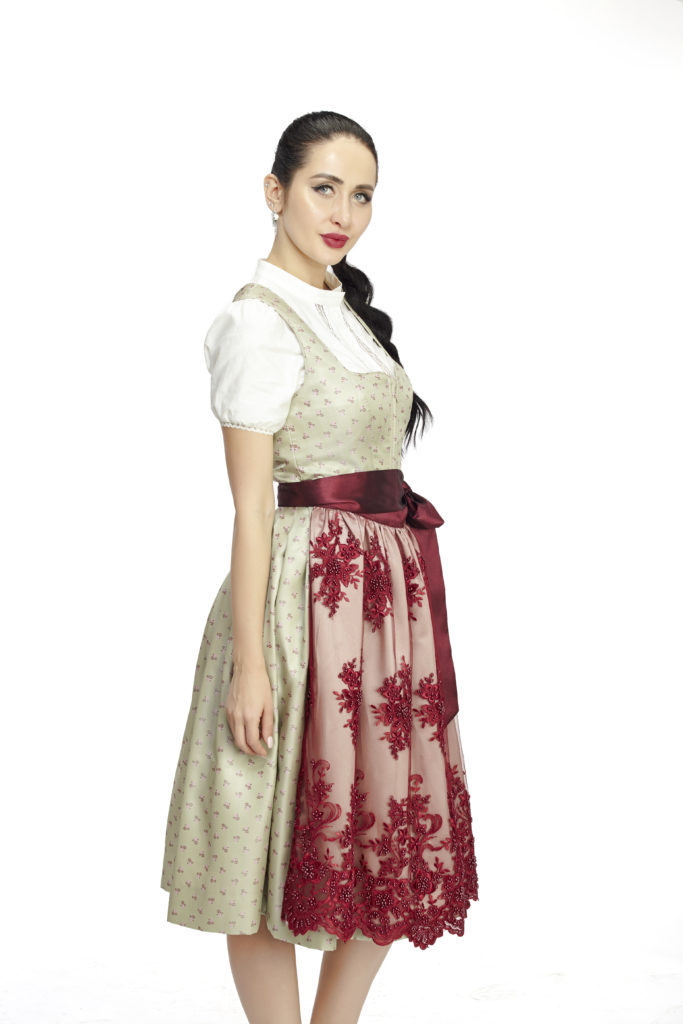
While traditional dirndl dresses remain popular, there are now many adaptations and variations available to suit different tastes and occasions. Here are a few styles to consider:
Traditional Dirndl Dresses
These dresses represent the classic style that originated in the Alpine regions and are the most well-known. They typically feature a fitted bodice, full skirt, and apron, and are made from cotton or wool fabrics in traditional colors such as green, red, and black.
Modern Adaptations
Many designers and dress manufacturers now offer modern adaptations of the traditional dirndl dress. These dresses may feature different fabrics, such as lace or chiffon, and may have sleeker, more fitted silhouettes. Colors and patterns may also be more contemporary, such as pastel hues or floral prints.
Evening Wear Dirndl Dresses
For more formal events, there are evening wear dirndl dresses that offer a more elegant and sophisticated look. These dresses often feature longer lengths, intricate details such as beading or sequins, and luxurious fabrics such as silk or velvet.
Factors to Consider When Choosing a Dirndl Dress

Choosing the right dirndl dress can be overwhelming given the variety of designs, colors, and styles available. Here are some critical factors to consider when selecting a dirndl dress that suits your body type, occasion, style, and preferences:
Body Type and Size
Dirndl dresses are available in both standard and plus sizes, so ensure you select one that flatters your curves and enhances your best features. A-line designs are flattering for most body types, while ladies with a petite frame can opt for shorter, flared skirts to elongate their legs.
Occasion and Venue
Dirndl dresses are popular attire for cultural events, weddings, beer festivals, and other festive occasions. The occasion will play a significant role in determining the style, color, and fit of your dirndl dress.
For example, if attending a daytime festival, a shorter, more casual dress with bright colors or floral patterns may be the perfect choice, while a formal evening event would require a more elegant, long dress in a muted or darker tone.
Style and Color
With a range of styles and colors to choose from, selecting a dirndl dress can be a daunting task.
When it comes to the style, consider your personal preferences and the occasion. For example, if looking for a more traditional dress, a classic design with a fitted bodice and full skirt in a solid color may be the perfect choice. However, if you wish to try a more contemporary design, a playful and colorful dress with modern patterns or textures may be preferable.
When selecting a color, try to choose one that matches your skin tone and enhances your natural features.
Overall, when choosing a dirndl dress, consider your body type, the occasion and venue, and your personal style, and preferences. Keep in mind that the perfect dirndl dress should not only look great but also be comfortable and practical while allowing you to enjoy the event with ease.
How to Accessorize a Dirndl Dress

Accessories can elevate the look of a dirndl dress and add more personality and style to the outfit. Here are a few tips to help you accessorize your dirndl dress:
Jewelry and Accessories
A dirndl dress lends itself well to traditional jewelry such as pearl or silver necklaces, bracelets, and earrings. You can also accessorize with a brooch, scarf, hat, or a traditional flower crown known as a Gamsbart. A traditional handbag or purse also complements the look of a dirndl dress.
Hairstyles
A hairstyle that goes well with a dirndl dress depends on the neckline of the blouse. If your blouse has a high neckline, consider wearing your hair up in a bun or braids and adding accessories such as a hairband or hairpins. If your blouse has a lower neckline, you can wear your hair loose or styled in loose waves or curls.
Footwear
When it comes to footwear choices for a dirndl dress, there are several options available. Traditional leather shoes with a short heel, known as Haferlschuhe, are the most common choice, but ballet flats or ankle boots also pair nicely with the dress. Ensure that your footwear is comfortable and practical for the occasion as you may be standing or walking for extended periods.
In conclusion, accessorizing your dirndl dress with jewelry, traditional accessories, suitable hairstyle, and appropriate footwear can complete the look and make you feel more confident and comfortable. Depending on your personal style and the occasion, you can choose from several options to create your unique look.
Caring for Your Dirndl Dress
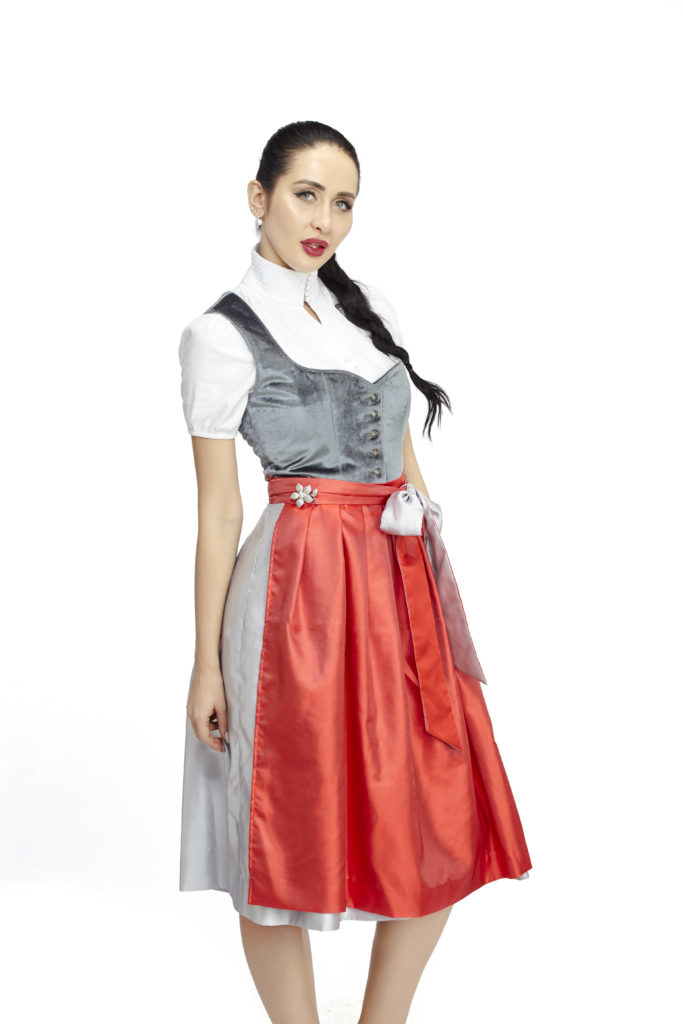
A dirndl dress is a special piece of clothing that deserves proper care and attention to ensure its longevity and quality. Here are some tips on how to care for and store your dirndl dress properly:
Cleaning & Storage
Always check the care instructions on the label before cleaning your dirndl dress. Most dirndl dresses with cotton and washable materials can be safely machine washed at low temperatures. Some dresses may require dry cleaning or hand washing.
Proper storage is also essential to maintain its quality. Store your dirndl dress in a cool, dry place, away from sunlight, and avoid hanging it on wire hangers as they can stretch and deform the fabric. Instead, use a padded hanger, or fold the dress neatly and store it in a box or garment bag to protect it from dust and light.
Removing Stains & Wrinkles
To remove stains from your dirndl dress, it’s essential to act quickly. Treat the area with a stain remover or a mild detergent and gently rub with a soft cloth. Avoid using hot water or bleach, as they may damage the fabric.
Proper ironing techniques can remove any wrinkles or creases from your dirndl dress. When ironing, make sure to use low to medium heat and use a steam iron if possible. Only iron on the inside of the dress or on the lowest iron setting if ironing the outside.
By following these tips, you can keep your dirndl dress in excellent condition for years to come. Proper care and storage will ensure that your dress retains its quality and appeal, making it a valuable addition to your wardrobe for any occasion.
Conclusion
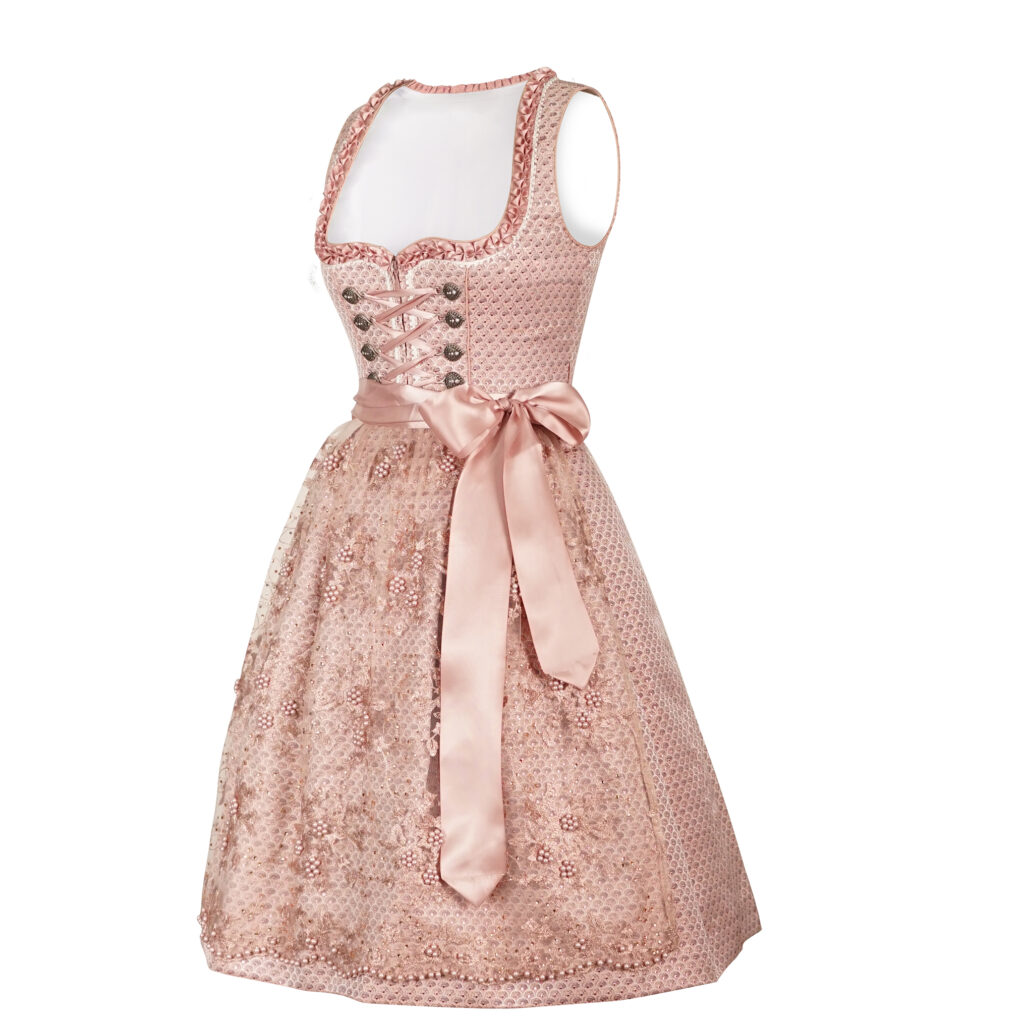
In conclusion, wearing a dirndl dress can be a fun and stylish way to celebrate cultural events and special occasions. Choose a dress that fits your body type, accessorize it appropriately, care for it properly, and follow dress code guidelines.
As a dress manufacturer specializing in dirndl dresses, our company offers high-quality, authentic designs. Visit our website to browse our collection and elevate your wardrobe today.
FAQs
- What are the components of a dirndl?
- A: The main elements that make up a Dirndl are the wide skirt or fitted bodice, an apron (often with a hidden pocket), and a short Dirndl blouse.
- Can you wear a dirndl without a blouse?
- A: Some dirndl dresses feature higher bodices and can be worn as two-pieces without a blouse; otherwise, you will need to remember to add a blouse to your dress and can choose between short puff and elbow-length sleeves.
- Can you wear a dirndl everyday?
- A: In Bavaria, one can wear a Dirndl on several different occasions like family celebrations, weddings, christenings, or something similar. However, you most likely won’t see Bavarians wearing Dirndl or Lederhosen in everyday life (despite they are working at the Biergarten).
- What are the traditional colors of dirndl dresses?
- A: Traditional colors are black, blue and soft pink, but today anything goes from silver and gold to electric pink and toxic green. The blouse is almost always white.
- What does the dirndl knot mean?
- A: If the knot of the apron is tied in the front, towards the left side, it means that a woman is single.


